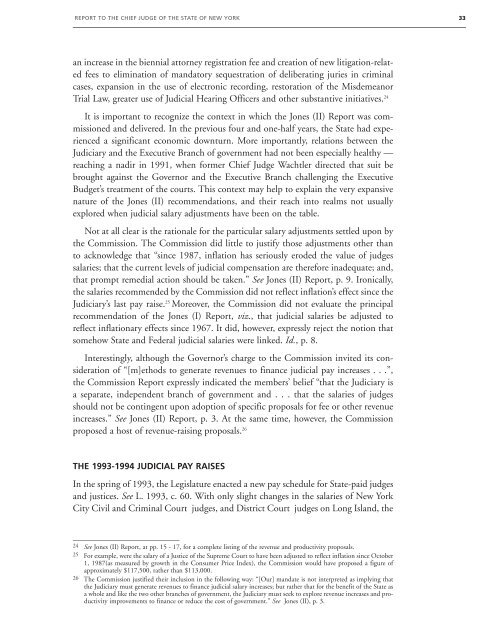Judicial Compensation in New York: A National Perspective, Report
Judicial Compensation in New York: A National Perspective, Report
Judicial Compensation in New York: A National Perspective, Report
Create successful ePaper yourself
Turn your PDF publications into a flip-book with our unique Google optimized e-Paper software.
REPORT TO THE CHIEF JUDGE OF THE STATE OF NEW YORK 33<br />
an <strong>in</strong>crease <strong>in</strong> the biennial attorney registration fee and creation of new litigation-related<br />
fees to elim<strong>in</strong>ation of mandatory sequestration of deliberat<strong>in</strong>g juries <strong>in</strong> crim<strong>in</strong>al<br />
cases, expansion <strong>in</strong> the use of electronic record<strong>in</strong>g, restoration of the Misdemeanor<br />
Trial Law, greater use of <strong>Judicial</strong> Hear<strong>in</strong>g Officers and other substantive <strong>in</strong>itiatives. 24<br />
It is important to recognize the context <strong>in</strong> which the Jones (II) <strong>Report</strong> was commissioned<br />
and delivered. In the previous four and one-half years, the State had experienced<br />
a significant economic downturn. More importantly, relations between the<br />
Judiciary and the Executive Branch of government had not been especially healthy —<br />
reach<strong>in</strong>g a nadir <strong>in</strong> 1991, when former Chief Judge Wachtler directed that suit be<br />
brought aga<strong>in</strong>st the Governor and the Executive Branch challeng<strong>in</strong>g the Executive<br />
Budget’s treatment of the courts. This context may help to expla<strong>in</strong> the very expansive<br />
nature of the Jones (II) recommendations, and their reach <strong>in</strong>to realms not usually<br />
explored when judicial salary adjustments have been on the table.<br />
Not at all clear is the rationale for the particular salary adjustments settled upon by<br />
the Commission. The Commission did little to justify those adjustments other than<br />
to acknowledge that “s<strong>in</strong>ce 1987, <strong>in</strong>flation has seriously eroded the value of judges<br />
salaries; that the current levels of judicial compensation are therefore <strong>in</strong>adequate; and,<br />
that prompt remedial action should be taken.” See Jones (II) <strong>Report</strong>, p. 9. Ironically,<br />
the salaries recommended by the Commission did not reflect <strong>in</strong>flation’s effect s<strong>in</strong>ce the<br />
Judiciary’s last pay raise. 25 Moreover, the Commission did not evaluate the pr<strong>in</strong>cipal<br />
recommendation of the Jones (I) <strong>Report</strong>, viz., that judicial salaries be adjusted to<br />
reflect <strong>in</strong>flationary effects s<strong>in</strong>ce 1967. It did, however, expressly reject the notion that<br />
somehow State and Federal judicial salaries were l<strong>in</strong>ked. Id., p. 8.<br />
Interest<strong>in</strong>gly, although the Governor’s charge to the Commission <strong>in</strong>vited its consideration<br />
of “[m]ethods to generate revenues to f<strong>in</strong>ance judicial pay <strong>in</strong>creases . . .”,<br />
the Commission <strong>Report</strong> expressly <strong>in</strong>dicated the members’ belief “that the Judiciary is<br />
a separate, <strong>in</strong>dependent branch of government and . . . that the salaries of judges<br />
should not be cont<strong>in</strong>gent upon adoption of specific proposals for fee or other revenue<br />
<strong>in</strong>creases.” See Jones (II) <strong>Report</strong>, p. 3. At the same time, however, the Commission<br />
proposed a host of revenue-rais<strong>in</strong>g proposals. 26<br />
THE 1993-1994 JUDICIAL PAY RAISES<br />
In the spr<strong>in</strong>g of 1993, the Legislature enacted a new pay schedule for State-paid judges<br />
and justices. See L. 1993, c. 60. With only slight changes <strong>in</strong> the salaries of <strong>New</strong> <strong>York</strong><br />
City Civil and Crim<strong>in</strong>al Court judges, and District Court judges on Long Island, the<br />
24 See Jones (II) <strong>Report</strong>, at pp. 15 - 17, for a complete list<strong>in</strong>g of the revenue and productivity proposals.<br />
25 For example, were the salary of a Justice of the Supreme Court to have been adjusted to reflect <strong>in</strong>flation s<strong>in</strong>ce October<br />
1, 1987(as measured by growth <strong>in</strong> the Consumer Price Index), the Commission would have proposed a figure of<br />
approximately $117,500, rather than $113,000.<br />
26 The Commission justified their <strong>in</strong>clusion <strong>in</strong> the follow<strong>in</strong>g way: “[Our] mandate is not <strong>in</strong>terpreted as imply<strong>in</strong>g that<br />
the Judiciary must generate revenues to f<strong>in</strong>ance judicial salary <strong>in</strong>creases; but rather that for the benefit of the State as<br />
a whole and like the two other branches of government, the Judiciary must seek to explore revenue <strong>in</strong>creases and productivity<br />
improvements to f<strong>in</strong>ance or reduce the cost of government.” See Jones (II), p. 3.
















